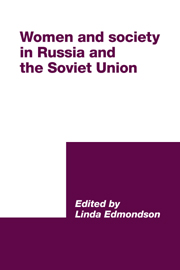Book contents
- Frontmatter
- Contents
- Notes on contributors
- Preface
- Introduction
- 1 ‘Better halves’? Representations of women in Russian urban popular entertainments, 1870-1910
- 2 The Silver Age: highpoint for women?
- 3 Women pharmacists in Russia before World War I: women's emancipation, feminism, professionalization, nationalism and class conflict
- 4 Women's rights, civil rights and the debate over citizenship in the 1905 Revolution
- 5 Laying the foundations of democracy in Russia: E. D. Kuskova's contribution, February–October 1917
- 6 Mariia L. Bochkareva and the Russian amazons of 1917
- 7 Russian women writers: an overview. Post-revolutionary dispersion and adjustment
- 8 Victim or villain? Prostitution in post-revolutionary Russia
- 9 Young women and perestroika
- 10 Glasnost and the woman question
- Index
7 - Russian women writers: an overview. Post-revolutionary dispersion and adjustment
Published online by Cambridge University Press: 22 October 2009
- Frontmatter
- Contents
- Notes on contributors
- Preface
- Introduction
- 1 ‘Better halves’? Representations of women in Russian urban popular entertainments, 1870-1910
- 2 The Silver Age: highpoint for women?
- 3 Women pharmacists in Russia before World War I: women's emancipation, feminism, professionalization, nationalism and class conflict
- 4 Women's rights, civil rights and the debate over citizenship in the 1905 Revolution
- 5 Laying the foundations of democracy in Russia: E. D. Kuskova's contribution, February–October 1917
- 6 Mariia L. Bochkareva and the Russian amazons of 1917
- 7 Russian women writers: an overview. Post-revolutionary dispersion and adjustment
- 8 Victim or villain? Prostitution in post-revolutionary Russia
- 9 Young women and perestroika
- 10 Glasnost and the woman question
- Index
Summary
By the turn of the century and throughout the Silver Age, Russian women writers had moved into the ranks of the profession, becoming increasingly visible and recognized by their peers as well as their audience. Some women writers were very successful and earned considerable rewards, others not. But by and large, this movement pointed towards a progressive acceptance of women writers as meaningful participants in the creative process of Russian literature and their eventual full integration into the dominant canon. The events of the First World War, the Revolution and the Civil War brought about significant changes in this promising development. The revolution and the civil war split Russia in two, literally and figuratively: one lost the very name of Russia and became first the RSFSR and then the USSR; the other, defeated by Lenin's government, rejecting and escaping the newly created RSFSR, constituted itself into a Russia beyond the borders, Russia Abroad.’ An approximate periodization should provide some orientation in the further development of Russian women writing in the post-1917 period.
As is well known, in the early period of the division ‘both Russias’ continued to promote modernism in its various forms at least until well into the twenties.
- Type
- Chapter
- Information
- Women and Society in Russia and the Soviet Union , pp. 145 - 159Publisher: Cambridge University PressPrint publication year: 1992



